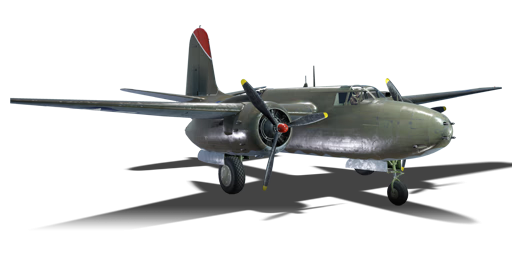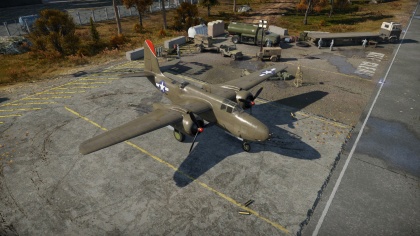A-20G-25
Contents
Description
The A-20G-25 Havoc is a Rank II American attacker with a battle rating of 2.7 (AB) and 3.0 (RB/SB). It was in the game since the start of the Open Beta Test as the A-20G-30 before being remodeled and renamed in Update 1.47 "Big Guns" to the A-20G-25.
The A-20 is classified as an attacker, which carries both good and bad traits when compared to "real" bombers. The main advantage is it's strong offensive armament (comparable to that of many U.S fighters), which allows it to engage other aircraft or to strafe soft ground targets. Additionally, it carries an excellent defensive armament, with 2 x 12.7 mm machine guns mounted in a dorsal turret, and a single 12.7 mm machine gun in a hatch below the tail. However, in-game attackers are treated differently than bombers, spawning at lower altitude and in Realistic Mode they do not benefit from a bomb-sight.
Due to its lack of manuverability, turn fighting or energy fighting enemy aircraft is extremely ill-advised, since the A-20G isn't capable of out-turning anything (even heavy fighters), and it's energy retention is very poor. If one must engage an enemy fighter, either make sure to have a significant energy advantage in order to use boom-and-zoom tactics, or try to provoke them into a head-on pass, since not much can compete with the A-20G's armament. If an enemy plane avoids a head on engagement, it is likely better to avoid turning, and use the speed of this plane to either get to help or to allow your gunners to engage the fighters. Often, the best defensive tactic is to stay at very low altitude in to force the enemy into the dorsal turret's coverage area and hope it can deal with it, as the A-20G is hopeless in any kind of combat manuvering otherwise.
General info
Flight Performance
| Characteristics | |||||||
|---|---|---|---|---|---|---|---|
| Stock | |||||||
| Max Speed (km/h at 3,048 m) |
Max altitude (meters) |
Turn time (seconds) |
Rate of climb (meters/second) |
Take-off run (meters) | |||
| AB | RB | AB | RB | AB | RB | ||
| 491 | 476 | 7,224 | 35.6 | 36.2 | 6.1 | 7.7 | 604 |
| Upgraded | |||||||
| Max Speed (km/h at 3,048 m) |
Max altitude (meters) | Turn time (seconds) | Rate of climb (meters/second) |
Take-off run (meters) | |||
| AB | RB | AB | RB | AB | RB | ||
| 532 | 510 | 7,224 | 32.6 | 34.0 | 15.5 | 10.1 | 604 |
Details
| Features | ||||
|---|---|---|---|---|
| Combat flap | Take-off flap | Landing flap | Air brakes | Arrestor gear |
| ✓ | ✓ | ✓ | X | X |
| Limits | ||||
|---|---|---|---|---|
| Wing-break speed (km/h) |
Gear limit (km/h) |
Combat flap (km/h) |
Max Static G | |
| + | - | |||
| 633 | 450 | ??? | ~9 | ~?3 |
| Optimal velocities | |||
|---|---|---|---|
| Ailerons (km/h) |
Rudder (km/h) |
Elevators (km/h) |
Radiator (km/h) |
| < 260 | < 320 | < 320 | > 200 |
| Compressor (RB/SB) | ||
|---|---|---|
| Setting 1 | ||
| Optimal altitude | 100% Engine power | WEP Engine power |
| 467 m | 2,700 hp | 3,200 hp |
| Setting 2 | ||
| Optimal altitude | 100% Engine power | WEP Engine power |
| 2,906 m | 2,500 hp | 3,022 hp |
Survivability and armour
- 12.7 mm Steel - Fore cockpit armor plate
- 8 mm Steel - Fore cockpit side armor plate
- 9.5 mm Steel - Pilot's seat
- 12.7 mm Steel - Dorsal gunner's fore and aft armor plating
- 12.7 mm Steel - Ventral gunner's belly armor plating
- 12.7 mm Steel - Ventral gunner's rear armor plating
- No armour glazing
- Critical components located at front of aircraft (fuel, pilot, engine, controls)
- More fuel tanks located in wings near fuselage
Armaments
Offensive armament
The A-20G-25 is armed with:
- 4 x 12.7 mm Browning M2 machine guns, nose-mounted (350 rpg = 1,400 total)
- 2 x 12.7 mm Browning M2 machine guns, chin-mounted (350 rpg = 700 total)
Suspended armament
The A-20G-25 can be outfitted with the following ordinance:
- Without load (not an option with this aircraft)
- 12 x M8 rockets
- 4 x 500 lb AN-M64A1 bombs (2,000 lb total)
Defensive armament
The A-20G-25 is defended by:
- 2 x 12.7 mm Browning M2 machine guns, dorsal turret (400 rpg = 800 total)
- 1 x 12.7 mm Browning M2 machine guns, ventral turret (400 rpg)
Usage in the battles
The A-20G-25 possesses a fairly standard loadout of 6 x 12.7 mm machine guns like many regular fighters in the U.S tech tree. However unlike the fighters, the machine guns on the A-20 are mounted solely in the nose. This allows for a much more focused cone of fire at range since convergence is not a significant factor, meaning that the A-20G will have an easier time hitting targets, but hardened ground targets like light and medium tanks will be easier to kill due to the fact that bullets are not converging from an angle, increasing penetration.
In general, either stealth or universal belts are recommendable for most situations. While the ground targets belt does make it feasible to kill medium tanks with the 12.7 mm machine guns, the angles required for dealing damage are so specific, you end up putting a fairly unmanoeuvrable plane at risk of crashing.
Manual Engine Control
| MEC elements | ||||||
|---|---|---|---|---|---|---|
| Mixer | Pitch | Radiator | Supercharger | Turbocharger | ||
| Oil | Water | Type | ||||
| Controllable | Not controllable | Not controllable | Not controllable | Separate | Not ontrollable | Not controllable |
Modules
| Tier | Flight performance | Survivability | Weaponry | ||
|---|---|---|---|---|---|
| I | Fuselage Repair | Radiators | Offensive 12 mm | ||
| II | Compressor | Airframe | New 12 mm MGs | ||
| III | Wings Repair | Engine | Turret 12 mm | Rocket Launcher M10 | |
| IV | Engine Injection | Cover | New 12 mm MGs (turret) | ||
Pros and cons
Pros:
- Great armament consisting of 6 x 12.7 mm machine guns that are all mounted in the nose
- Defensive armament
- Decent acceleration and speed
- Decent protection
- Can take a lot of damage from similarly tiered planes before going down
- Powerful payload
Cons:
- Poor turn rate
- Poor climb rate
- Large target
- Poor energy retention
- Bazooka rocket positioning makes direct hits difficult
- Despite having largely superior flight characteristics compared to other bombers, it will still get outperformed by any fighter in a dogfight
- Performing a barrel roll in level flight, will fuel starve your engines
- Pulling negative G's will starve the engines in realistic battle mode
History
In 1936 a design team from Douglas Aircraft set out to create a light bomber. The design would be based around a high mounted wing and tricycle landing gear. It was to be powered by a pair of 450 hp Pratt & Whitney engines. It was know as the Douglas Model 7A. The projected was shelved with design work nearly half way completed. Based on information from the Spanish Civil War, the U.S. Army put of a specification for a new airplane. The requirements was a cruising speed of 200 mph and a range of 1200 miles. It was to also consist of a 1,200 lb bomb load. Douglas then revised the design to meet these requirements. It was knows as the Douglas Model 7B.
A French purchasing commission touring U.S. aircraft companies was informed of the new design. They received permission from the U.S. government to spectate the performance trials. The commission was impressed with the airplane and received further permission to participate in the flight test. The French placed a order for 100 aircraft and was quickly increased to 270. They also requested changes to the aircraft's design including: better range, payload, additional armor, and french specific equipment. This new design was designated DB-7. France was defeated before a majority of the aircraft could be delivered. The remaining aircraft order was diverted to the British and was designated the Boston.
The U.S. Army Air Corps ordered the aircraft in June of 1939. The army requested several changes. The primary change were new engines with superchargers. The aircraft was designated A-20. The original order was for 63 aircraft, with 60 aircraft delivered. The follow on order was for the A-20A without the superchargers, 140 ordered. The A-20G was the first solid nose A-20. Originally armed with 4 x 20 mm cannons, they were later changed for the M2 Browning. This was also the first A-20 with a powered turret. A total of 2,850 A-20Gs were built.
The US, France, Britain, and Russia all made extensive use of the A-20. Used in France and Russia as low level attackers, the A-20 was considered overpowered, easy to fly, and easy to care for, even by inexperienced and lightly trained crews. The A-20 saw combat in all theaters of World War II. This aircraft filled many roles including: Bomber, Fighter, Recon, Attacker, and Night Fighter.
Media
An excellent addition to the article will be video guides, as well as screenshots from the game and photos.
Read also
Links to the articles on the War Thunder Wiki that you think will be useful for the reader, for example,
- reference to the series of the aircraft;
- links to approximate analogues of other nations and research trees.
Sources
Paste links to sources and external resources, such as:
- topic on the official game forum;
- page on aircraft encyclopedia;
- other literature.
| USA strike aircraft | |
|---|---|
| Douglas | A-20G-25 · A-26B-10 · A-26B-50 · A2D-1 · AD-2 · AD-4 · A-1H |
| North American | A-36 · PBJ-1H · PBJ-1J |
| Other | AM-1 · AU-1 · XA-38 |





